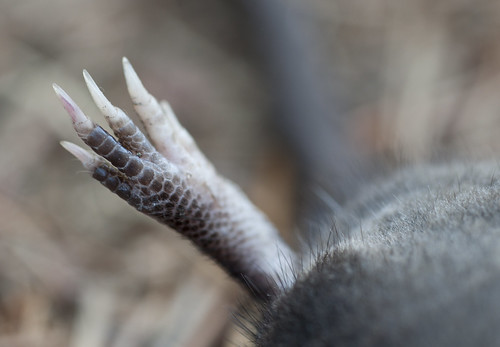I came across one, dead, a few days ago. It was lying upside-down on a bike bath, having only just died, probably less than an hour before. There was no sign of what had killed the mole, though it seemed to have a few puncture wounds in its back that were bleeding. Because moles are in the same order as shrews, I assumed that the mole had a bad taste that repelled its would-be predator. However, that assumption was false: star-nosed moles do not possess a bad taste or smell, so why the body was left remains a mystery.
Star-nosed moles are wonderful and bizarre in appearance. Their dark fur is dense and silky, and is water-repellant: which makes sense, as these moles live in damp habitats and can swim in pursuit of prey. The tail is long, scaly, and sparsely covered in thick hairs. The eyes are almost non-existent, and may be useful only for distinguishing between light and dark surroundings. The front feet have evolved perfectly over millions of years, and are amazing digging machines.
But, perhaps most bizarre and fantastic is the star-nosed mole's namesake: its nose.
This nose may well be the most sensitive, highly-developed nose in the animal kingdom. It is adorned with eleven pairs of tentacles – all of which can move independently – and each tentacle is covered with thousands of tiny sensory receptors called Eimer's organs. With this nose, the mole can effectively "see" its surroundings, in a way completely different than humans and most other vertebrates. It is perfect for detecting and catching the star-nosed mole's favorite prey: earthworms.
After photographing the mole, I skinned it, and was amazed to see the structure of the head. The eyes were the size of poppy seeds, if not smaller, the snout was ridiculously long, and the teeth were tiny, sharp, and numerous. Unsurprisingly, the muscles on the forelegs were extremely well-developed.
Because star-nosed moles are so secretive, and their habitat doesn't
usually intersect with gardens or lawns, they're not a common sight. I
feel very fortunate to have found this animal! To see a star-nosed mole in action, watch this video. They are amazingly fast!







What an amazing mole! We only have the common moles here arround. Did you tanned the fur and cleaned the skull?
ReplyDeleteThanks! The skin is still in the freezer... I'm going to preserve it using a dry-preservative method, then mount it on a little form. As far as the skull goes, it's macerating in a container of water. Hopefully it will be done soon, it is just so cool-looking!
DeleteDon't call them useless.😟
ReplyDeleteThis is neat, I like it.
ReplyDelete